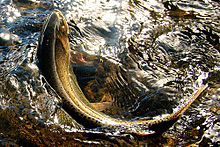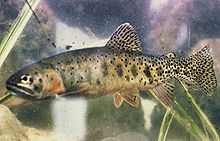- Cutthroat trout
-
Cutthroat Trout 
Greenback cutthroat trout, O. c. stomias Scientific classification Kingdom: Animalia Phylum: Chordata Class: Actinopterygii Order: Salmoniformes Family: Salmonidae Genus: Oncorhynchus Species: O. clarkii Binomial name Oncorhynchus clarkii
(Richardson, 1836)[1]Subspecies Oncorhynchus clarkii clarki
O. c. alvordensis(extinct)
O. c. behnkei
O. c. bouvieri
O. c. henshawi (threatened)
O. c. lewisi
O. c. macdonaldi (extinct)
O. c. pleuriticus
O. c. seleniris (threatened)
O. c. stomias (threatened)
O. c. utah
O. c. virginalisThe cutthroat trout (Oncorhynchus clarkii) is a species of freshwater fish in the salmon family of order Salmoniformes.[2] It is one of the many fish species colloquially known as trout. All subspecies of cutthroat trout are sought after gamefish, especially among anglers who enjoy fly fishing.
Several native subspecies of cutthroat are currently listed as threatened, generally due to loss of habitat and introduction of non-native species.
Contents
Range and habitat
Cutthroat trout are native to western North America. The cutthroat species has evolved through geographic isolation into many subspecies, each native to a different major drainage basin. Native cutthroat species are found along the Pacific Northwest coast, in the Cascade Range, the Great Basin, and throughout the Rocky Mountains. Some coastal populations are anadromous, living primarily in the Pacific Ocean as adults and returning to fresh water from fall through early spring to feed on insects and spawn. Most populations, however, stay in freshwater throughout their lives and are known as non-migratory, stream-resident or riverine populations. Anadromous fish may reach weights of 20 pounds (9 kg), but those fish which remain permanently in freshwater may only reach a weight of 2 pounds (1 kg). At least three subspecies are confined to isolated basins in the Great Basin and can tolerate saline or alkaline water.
Description
Throughout their native and introduced range, cutthroat trout vary widely in size, coloration, and habitat selection. Though their coloration can range from golden to gray to green on the back, and depending on subspecies strain and habitat, they usually feature distinctive red, pink, or orange linear marks along the underside of the mandible in the lower folds of the gill plates; the easiest diagnostic of the species for the casual observer. These markings are responsible for the formation of the typical name "cutthroat". At maturity, different populations and subspecies of cutthroat can range from 6–40 inches (15–100 cm) in length, depending on habitat and food availability, making size an ineffective indicator as to species identity. Cutthroat are typically prized as a sportfish, particularly by fly anglers, as their propensity to inhabit remote waters and dimunitive streams appeals to the sense of adventure present in many outdoor enthusiasts. In addition, their tendency to exhibit significant activity and resistance to anglers in conjunction with this species' affinity for terrestrial or mature insects serves to increase popularity of the cutthroat as a angler's quarry. Finally, the cutthroat participates in a unique predator-prey relationship with the bull trout that is key to ecosystem integrity across much of its natural range.
Cutthroat will readily interbreed with the closely related rainbow trout, producing fertile hybrids commonly called "cutbow". As this species generally bears similar coloration and overall appearance to the cutthroat, retaining the characteristic orange-red slash, these hybrids often pose a taxonomical difficulty. In addition, Cutthroat will also hybridize with the O. gilae subspecies, the Gila trout and Apache trout in regions where their ranges overlap.
Subspecies
There are many subspecies of cutthroat, each native to a separate geographic area. The cutthroat trout is thought[who?] to have evolved over the past two million years from other Oncorhynchus species which migrated up the Columbia and Snake river basins. There are at least 10, and perhaps more than 14 subspecies,[2][3] including:
Pacific Coast
- Coastal cutthroat trout O. c. clarki, also known as "sea-run" cutthroat; native from northern California to Alaska.[3]
- Crescenti trout O. c. crescenti, no longer a recognized subspecies, but a unique population of coastal cutthroat endemic to Lake Crescent, Washington state.[4]
Great Basin
- Alvord cutthroat trout O. c. alvordensis, endemic to tributaries of Alvord Lake in southeastern Oregon; considered extinct. Named in 2002.
- Bonneville cutthroat trout O. c. utah, native to tributaries of the Great Salt Lake.
- Humboldt cutthroat trout O. c. spp., found only in the upper Humboldt River of northern Nevada.[4] Considered by some to be a population of O. c. henshawi.
- Lahontan cutthroat trout O. c. henshawi, western Nevada, designated as threatened.[5]
- Paiute cutthroat trout O. c. seleniris, endemic to eastern Sierra Nevada Mountains, designated as threatened.
Northern Rockies
- Snake River fine-spotted cutthroat trout, named O. c. behnkei (1995 & 2002), but some consider it a population of O. c. bouvieri. Native to the Snake River of Idaho and Wyoming.
- Westslope cutthroat trout O. c. lewisi, native to northern Idaho, Montana, British Columbia, and Alberta.
- Yellowfin cutthroat trout O. c. macdonaldi, endemic to Twin Lakes, Colorado; now extinct.
- Yellowstone cutthroat trout O. c. bouvieri, native to the upper Snake River, Yellowstone Lake, and Yellowstone River, Idaho and Wyoming.
Southern Rockies
- Colorado River cutthroat trout O. c. pleuriticus, native to tributaries of the Green and Colorado Rivers.
- Greenback cutthroat trout O. c. stomias, native to the Arkansas and South Platte Rivers in eastern Colorado; designated as threatened.
- Rio Grande cutthroat trout O. c. virginalis, native to New Mexico and southern Colorado.
Trivia
The cutthroat trout is the state fish of Idaho and Wyoming, while particular subspecies of cutthroat are the state fish of Colorado, Montana, Nevada, New Mexico, and Utah.
Origin of the name
The common name "cutthroat" refers to the distinctive red coloration on the underside of the lower jaw.
Cutthoat trout were given the species name clarki in honor of William Clark, who co-led the Lewis and Clark Expedition of 1804–1806.[1] One of Lewis and Clark’s missions was to describe the flora and fauna encountered during the expedition. The type specimen of O. clarki was described by naturalist John Richardson from a tributary of the lower Columbia River, identified as the "Katpootl",[1] which was perhaps the Lewis River as there was a Multnomah village of similar name at the confluence. This type specimen was most likely the coastal cutthroat subspecies.
References
- ^ a b c Richardson, John; William Swainson, William Kirby (1836), Fauna boreali-americana, or, The zoology of the northern parts of British America: containing descriptions of the objects of natural history collected on the late northern land expedition, under command of Captain Sir John Franklin, R.N., London: J. Murray, pp. 225–226, http://books.google.com/?id=Cp4SAAAAYAAJ
- ^ a b "Oncorhynchus clarkii". Integrated Taxonomic Information System. http://www.itis.gov/servlet/SingleRpt/SingleRpt?search_topic=TSN&search_value=161983. Retrieved 23 April 2009.
- ^ a b Froese, Rainer, and Daniel Pauly, eds. (2005). "Oncorhynchus clarki" in FishBase. 10 2005 version.
- ^ a b c Behnke, Robert J. Native Trout of Western North America. American Fisheries Society, 1992 p. 65.
- ^ Species Profile: Lahontan cutthroat trout, U.S. Fish & Wildlife Service
- ^ Species Fact Sheet: Lahontan cutthroat trout, U.S. Fish & Wildlife Service
Categories:- Oncorhynchus
- Fish of the Pacific Ocean
- Fish of North America
- Fly fishing target species
- Cold water fish
- Fauna of the Sierra Nevada (U.S.)
- Symbols of Wyoming
- Coastal cutthroat trout O. c. clarki, also known as "sea-run" cutthroat; native from northern California to Alaska.[3]
Wikimedia Foundation. 2010.



